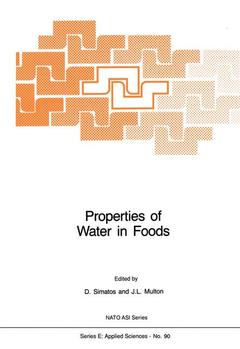Properties of Water in Foods, Softcover reprint of the original 1st ed. 1985 in Relation to Quality and Stability NATO Science Series E: Series, Vol. 90
Langue : Anglais
Coordonnateurs : Simatos D., Multon J.L.

Water is recognized as being an important factor in numerous pheno mena connected with the quality of food. For instance, it plays a part in the textural properties of several commodities. Moreover, water is an essential parameter determining the behaviour of food products in the course of many processing operations : on water, will depend the amount of energy necessary for freezing or dehydrating the product; water will strongly influence the evolution of physical, chemical and biochemical phenomena taking place in the product during processing operations such as heating, drying, etc. Water will also influence the same reactions, as well as the activity of microorganisms, during the storage of food products under various conditions. As a result, all aspects of quality - sensory, nutritional and hygienic properties of the food - will be affected. In all these circumstances, the water content of a product is obviously an important factor, but equally important may be the physical properties of this water, such as its thermodynamic activity and its mobility. Actual ly, the concept of water activity (a ) is now widely used by the food industry and in the legislation of sever')¥l countries. The idea of a small, international meeting devoted to a synthetic review and discussion of knowledge on these various matters, was first developed by Dr. R. B.
Session I. Fundamentals : high moisture systems.- Water and aqueous solutions : recent advances.- Phase separation in protein — water systems and the formation of structure.- The dipalmitoylphosphatidylcholine (DPPC) — water system.- An enzymatically modified protein as a new surfactant and its function to interact with water and oil in an emulsion system.- Session 2. Fundamentals : low and intermediate moisture systems.- The influence of soluble components on water sorption hysteresis.- Some facts concerning water vapour sorption hysteresis on potato starch.- Influence of temperature on sorption equilibria.- Development of B.E.T.-like models for sorption of water on foods, theory and relevance.- Solution thermodynamics and the starch-water system.- Session 3. Physico-chemical and enzymatic changes.- Effects of water activity and water content on mobility of food components, and their effects on phase transitions in food systems.- Enzyme activity as a function of water activity.- The influence of water content and temperature on the formation of Maillard reaction intermediates during the drying of plant products.- Polysaccharide-water interactions — thermal behavior of rice starch.- Session 4. Microbiology and water activity.- Present state of knowledge of aw effects on microorganisms.- Effects of aw and pH on growth and survival of Staphylococcus aureus.- Effect of aw on growth and survival of Bacillaceae.- Effect of water activity on mold growth and mycotoxin production.- The antimicrobial activity of sugar against pathogens of wounds and other infections of man.- Hurdle technology applied to meat products of the shelf stable product and intermediate moisture food types.- Session 5. Technology : diffusion properties and non equilibrium states.- Fundamentals of diffusion of water and rate of approach of equilibrium aw.- Diffusivity of sorbic acid in food gels at high and intermediate water activities.- Aroma diffusion : the influence of water activity and of molecular weight of the other solutes.- Choice of packages for foods with specific consideration of water activity.- The role of water in the rheology of hygroscopic food powders.- Session 6. Technology : humectants and new intermediate moisture foods (IMF).- A pragmatic approach to the development of new intermediate moisture foods.- Water binding of humectants.- Novel intermediate moisture meat products.- Extrusion cooking for cereal-based intermediate moisture products.- Polyglycerols and polyglycerol esters as potential water activity reducing agents. Chemistry and sensory analysis.- Session 7. Freezing and low temperature phenomena.- Complex aqueous systems at subzero temperatures.- The freezing of biological cells in aqueous solutions containing a polymeric cryo-protectant.- Freezing in polymer — water systems and properties of water.- Freeze-texturing and other aspects of the effects of freezing on food quality.- Computed instrumental analysis of the behavior of water in foods during freezing and thawing.- Session 8. Commodities : properties of water and technology.- Water in fish : its effects on quality and processing.- The effect of water on the quality of meat and meat products : problems and research needs.- Water in dairy products related to quality, with special reference to cheese.- Confectionery and water activity: determination of aw by calculation.- Session 9. Moisture measurement and prediction.- Comparison of sensors for measurement of air humidity.- Standardization of isotherm measurements (COST-project 90 and 90 bis).
Date de parution : 10-2011
Ouvrage de 694 p.
15.5x23.5 cm
Thèmes de Properties of Water in Foods :
Mots-clés :
Diffusion; Toxin; chemistry; enzymes; microbiology; microorganism; processing; rheology; thermodynamics
© 2024 LAVOISIER S.A.S.


